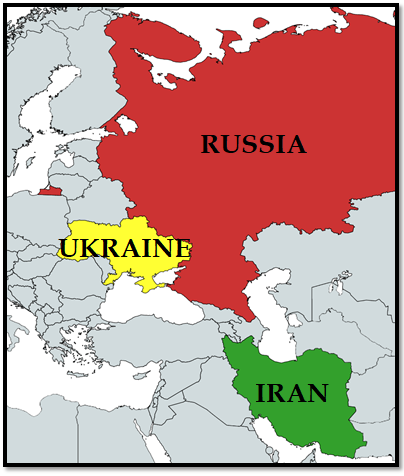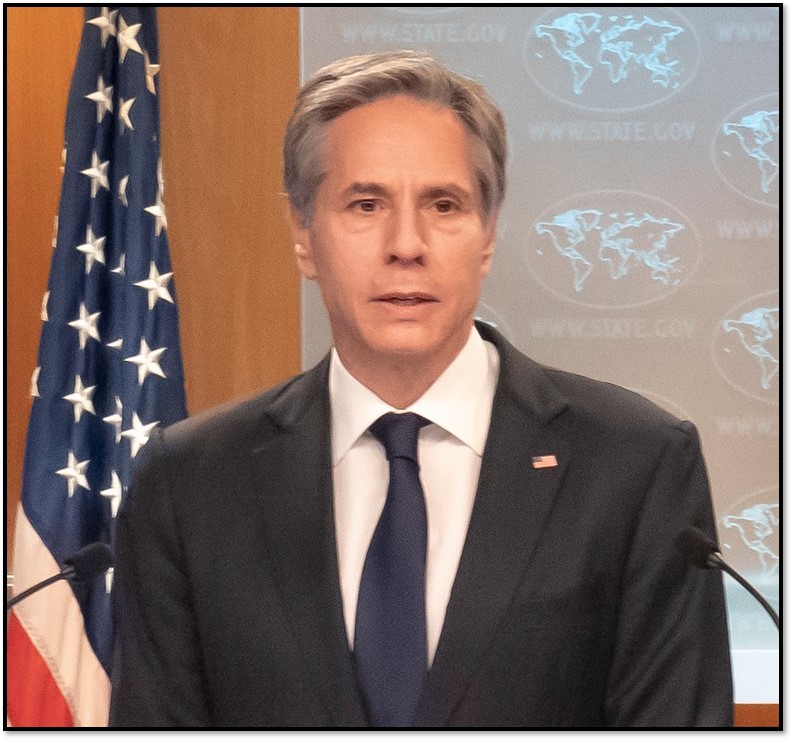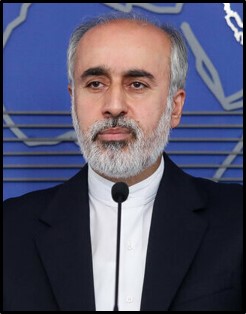Since mid-2022, Iran has become Russia’s top military backer, according to John Kirby of the National Security Council. Iran’s decision to aid Russia in the war on Ukraine reflected the expanding strategic alliance with Moscow. Since August, Iran has provided Russia with hundreds of drones, including the Shahed-136 suicide drone and the Mohajer-6 reconnaissance and strike drone. In November, Iran shipped artillery and tank rounds as well. Between October 2022 and April 2023, Tehran sent Moscow some 300,000 artillery shells and one million rounds of ammunition via the Caspian Sea, The Wall Street Journal reported.
Related Material - Explainer: Russia Deploys Iranian Drones
In exchange, “Russia has been offering Iran unprecedented defense cooperation, including on missiles, electronics and air defense,” Kirby said on Feb. 24, 2023, the one-year anniversary of the war. Tehran was also seeking to purchase Russian fighter jets, attack helicopters, radars, and combat trainer aircraft worth billions of dollars. Iranian pilots reportedly started training in Russia to fly the Sukhoi Su-35, an advanced fighter jet, in the spring of 2022. The Su-35 “would significantly strengthen Iran's air force relative to its regional neighbors,” Kirby has warned.

Iran has long sought to modernize its aging air force, which includes planes procured under the monarchy that are prone to breaking down. Its most modern aircraft were from the Soviet Union . For decades, Tehran has invested in drones and ballistic missiles as cheaper alternatives to modern fighters and bombers.
In the fall of 2022, Russia began firing Iranian suicide drones on Ukrainian military positions as well as residential buildings, power stations, bridges, playgrounds, sewage treatment plants and other infrastructure, killing civilians. Iran repeatedly denied that it had sent arms to Russia amid the conflict. In November 2022, Foreign Minister Hossein Amir-Abdollahian claimed that Tehran provided a “limited number” of drones before the war. He dismissed reports that Russia had used the drones against Ukraine.
Since September 2022, the United States designated more than two dozen individuals and entities over the weapons transfers between Iran and Russia. The sanctions included Iranian drone manufacturers and the Revolutionary Guards Aerospace Force, as well as the Wagner Group, a Russian mercenary force with close ties to the Kremlin. The following are statements by senior U.S. officials and a chronology of U.S. sanctions on Iran and Russia related to the weapons transfers.
On May 9, 2023 the United States revealed that Iran was supporting Russian efforts to build a drone factory hundreds of miles east of Moscow. The factory could start producing drones in 2024, according to Kirby. Tehran was reportedly providing materials for the facility, which would enable Russia to manufacture its own drone supply rather than importing drones from Iran via the Caspian Sea. “This is a full-scale defense partnership that is harmful to Ukraine, to Iran’s neighbors and to the international community,” Kirby said.
National Security Council Coordinator for Strategic Communications John Kirby
On the first anniversary of the war on Feb. 24, 2023: “Russia has had to rely on pariah states like North Korea and Iran to continue prosecuting this war. Since August, Iran has provided Russia with hundreds of UAVs, which Russia has used to attack Ukraine's critical infrastructure.”
 “Today, we have additional information that Iran’s support for Russia’s war is expanding. In November, Iran shipped artillery and tank rounds to Russia for use in Ukraine. And Russia is planning to cooperate with Iran to obtain even more military equipment.”
“Today, we have additional information that Iran’s support for Russia’s war is expanding. In November, Iran shipped artillery and tank rounds to Russia for use in Ukraine. And Russia is planning to cooperate with Iran to obtain even more military equipment.”
“In return, Russia has been offering Iran unprecedented defense cooperation, including on missiles, electronics and air defense. We believe that Russia might provide Iran with fighter jets. Iran is also seeking to purchase additional military equipment from Russia, including attack helicopters, radars, and the Yak-130 combat trainer aircraft. In total, Iran is seeking billions of dollars’ worth of military equipment from Russia.”
“We were concerned [the growing defense relationship between Iran and Russia] was going to go both ways. Those concerns are certainly becoming realized. And again, this defense cooperation is not only not good for the people of Ukraine—as Russia continues to get drones and potentially other capabilities—but certainly is not good for the Middle East, as Iran will seek to benefit from their cooperation with Russia to get Russian military capabilities to bolster their own military power there in the region.”
“We’re going to be watching this very closely to see what, if anything, actually transpires and whatever transactions are actually made.”
In a briefing on Dec. 9, 2022: “Iran is providing Russia with drones for use on the battlefield in Ukraine, drones that are being used to kill innocent Ukrainian people and destroy civilian infrastructure. In exchange, Russia is offering Iran an unprecedented level of military and technical support that is transforming their relationship into a full-fledged defense partnership. … This partnership poses a threat, not just to Ukraine, but to Iran's neighbors in the region. We have shared this information with partners in the Middle East and around the world.”
“Iran has become Russia's top military backer. Since August, Iran has transferred several hundred drones, UAVs, to Russia. Russia has been using these UAVs to attack Ukraine's critical infrastructure, and as I said earlier, to kill innocent Ukrainian people. The sales of UAVs [unmanned aerial vehicles] commenced after Russia's full-scale invasion of Ukraine, and Iranian drones are being used specifically to bolster Russia's capabilities there. Russia has been using Iranian drones to strike energy infrastructure, depriving millions of Ukrainians power, heat, critical services. People in Ukraine today are actually dying as a result of Iran's actions.

“We expect Iranian support for the Russian military to only grow in coming months. We even believe that Iran is considering the sale of hundreds of ballistic missiles from Iran to Russia. We've said that before. We've also seen reports that Moscow and Tehran are considering the establishment of a joint production line for lethal drones in Russia. We urge Iran to reverse course, not to take the steps.
“The support's flowing both ways. Russia is seeking to collaborate with Iran on areas like weapons development and training. As part of this collaboration, we are concerned that Russia intends to provide Iran with advanced military components. Moscow may be providing Tehran with equipment such as helicopters and air defense systems. As of this spring, Iranian pilots have reportedly been training in Russia to learn how to fly the Su-35. This indicates that Iran may begin receiving aircraft within the next year. These fighter planes would significantly strengthen Iran's air force relative to its regional neighbors.
“This is a full-scale defense partnership that is harmful, as I said to Ukraine, to Iran's neighbors, and quite frankly to the international community. And we're going to be using the tools at our disposal to expose and disrupt these activities, and we are prepared to do more. Russia and Iran have both violated obligations under U.N. Security Council 2231 by participating in these transfers of these drones from Iran to Russia without U.N. Security Council approval. We're going to continue to work with our allies and partners and with the U.N. on ways to hold them accountable. We're working with other countries to ensure their jurisdictions are not being exploited by Russia or Iran, and to prevent the movement of defense materiel transactions in support of this activity.
“As part of that effort, we're looking at options to bring together a group of like-minded countries to discuss Iran, Russia and military cooperation. We're also imposing costs on the actors involved in the transfer of Iranian drones to Russia for use in Ukraine.
“Today, we are announcing designations against three Russia-based entities that have been at the forefront of the acquisition and use of Iranian drones. These targets include the Russian Aerospace Forces, the intended beneficiary of the Russia-Iran agreement on transferring drones, and Russia's 924th State Center for Unmanned Aviation, which sent personnel to Iran to train on Iranian drones. We are obviously assessing further steps that we can take in terms of export controls to restrict Iran's access to sensitive technologies, and critically, we're working with allies and partners to ensure Ukraine has what it needs to defend and rebuild itself, including air defense equipment, and of course, electrical grid support.”
Secretary of State Antony Blinken
In a statement on Dec. 9, 2022: “Today, we are imposing sanctions on three Russian entities connected to Moscow’s growing military relationship with Tehran – a relationship that includes the transfer of unmanned aerial vehicles (UAV) from Iran. The Kremlin is deploying these UAVs against Ukraine, including in large-scale attacks on civilian infrastructure.

“Russia’s acquisition and Iran’s provision of these certain UAVs are in violation of UN Security Council Resolution 2231 and further fuels the conflict in Ukraine. The United States will continue to use every tool at our disposal to disrupt these transfers and impose consequences on those engaged in this activity.”
CIA Director Bill Burns
During an interview with CBS News Face the Nation on Feb. 26, 2023:
Question: You've said in the past, there's the beginnings of a full-fledged defense partnership between Russia and Iran. Exactly how far does the alliance go?
Burns: Well, it's moving at a pretty fast clip in a very dangerous direction right now, in the sense that we know that the Iranians have already provided hundreds of armed drones to the Russians, which they're using to inflict pain on Ukrainian civilians and Ukrainian civilian infrastructure. We know that they've provided ammunition for artillery and for tanks as well. And what we also see are signs that Russia is proposing to help the Iranians on their missile program and also at least considering the possibility of providing fighter aircraft to Iran as well. That creates obvious risks not only for the people of Ukraine, and we've seen the evidence of that already, but also risks to our friends and partners across the Middle East as well. So it's quite [a] disturbing set of developments.
Question: Have Iran's leaders made the decision to pursue a nuclear weapon?
Burns: To the best of our knowledge, we don't believe that the Supreme Leader in Iran has yet made a decision to resume the weaponization program that we judge that they suspended or stopped at the end of 2003. But the other two legs of the stool, meaning enrichment programs, they've obviously advanced very far over the past couple of years--
Question: 84 percent purity reportedly.
Burns: They've advanced very far to the point where it would only be a matter of weeks before they can enrich to 90 percent, if they chose to cross that line. And also in terms of their missile systems, their ability to deliver a nuclear weapon, once they developed it, has also been advancing as well. So the answer to your question is no, we don't see evidence that they made a decision to resume that weaponization program. But the other dimensions of this challenge, I think, are growing at a worrisome pace too.
Question: Israel has said they believe Iran has enough fuel for four bombs, and the enriched uranium that was found recently was at 84 percent purity- that's very close to 90 percent, what you need for a nuclear weapon. So how far are they from testing? Or are you saying because they haven't chosen to pursue a weapon that--
Burns: Right.
Question: We're not near that point?
Burns: Yeah. And they're still a ways off, at least in our judgment in terms of their ability to actually develop a weapon. But their progress on enrichment is quite troubling, as I said before.
Foreign Minister Hossein Amir-Abdollahian

On Oct. 24, 2022: “In the past we have taken weapons from Russia and given it weapons as well, but not during the Ukraine war.”
“I told [E.U. foreign policy chief] Josep Borrell that I am ready for a team of military experts from Iran and Ukraine to assess claims on the use of Iranian-made drones in the Ukraine war.”
To reporters on Nov. 5, 2022: “Their comments on the missiles part are completely wrong, and the drones part is correct. We gave a limited number of drones to Russia months and before the war in Ukraine.”
“We have emphasized to Ukrainian officials that if there is evidence about the use of Iranian drones in the Ukraine war by Russia, they should present it to us.”
“If it is proven to us that Russia has used Iranian drones in the Ukraine war, we won’t be indifferent to it.”
Foreign Ministry Spokesperson Nasser Kanaani

On Feb. 7, 2023: “The news that Iran and Russia are pressing ahead with plans to build a drone factory in Russia is completely untrue.”
“Iran is not interfering in the Ukraine war and is not siding with any party.”
“Unfortunately, the countries that are the biggest exporters of weapons and equipment to one side of the war want mislead the world public opinion by spreading false and fake news.”
On Feb. 24, 2023: “The military and defense relations between the Islamic Republic of Iran and the Russian Federation are within the framework of the common interests of the two countries and are not against any third country.”
“The military and defense relations between the Islamic Republic of Iran and the Russian Federation date back to the time before the beginning of the military crisis in Ukraine.”
U.S. Sanctions on Iran
Sept. 8, 2022
The United States sanctioned four Iranian companies and a defense contractor for providing drones to Russia for use in Ukraine. The move reflects a tightening of the sanctions noose around countries facilitating Vladimir Putin’s war machine. “The Russian military is suffering from major supply shortages in Ukraine, in part because of sanctions and export controls, forcing Russia to turn to unreliable countries like Iran for supplies and equipment,” Secretary of State Antony Blinken said in a statement. “The United States will hold those who support Russia’s unprovoked war against Ukraine to account, including by continuing to sanction Iranian or other entities that provide lethal aid to Russia.”
- Safiran Airport Services: The Tehran-based firm coordinated military flights between Iran and Russia.
- Paravar Pars Company: The drone manufacturer was linked to the Islamic Revolutionary Guard Corps (IRGC).
- Design and Manufacturing of Aircraft Engines: The firm was involved in the IRGC’s Shahed-171 drone program.
- Baharestan Kish Company: The firm managed Iranian drone manufacturing projects.
- Rehmatollah Heidari: The Iranian man was Baharestan Kish Company’s managing director and a board of directors member.
For more information on this round of sanctions: U.S. Sanctions Iran for Providing Drones to Russia
Nov. 15, 2022
The United States imposed sanctions on Iranians and Russians involved in the export of drones used in Ukraine. The State and Treasury Departments designed three Iranian entities, a Russian paramilitary, two Russian nationals, and two transportations firms based in the United Arab Emirates. The United States is “determined to sanction people and companies, no matter where they are located, that support Russia’s unjustified invasion of Ukraine,” Treasury Secretary Janet Yellen warned in a statement.
- Shahed Aviation Industries Research Center: The Iranian company produced the Shahed-136 suicide drone used by Russia against Ukraine.
- Qods Aviation Industries: The Iranian company produced the Mohajer-6 attack and reconnaissance drone used by Russia against Ukraine.
- Islamic Revolutionary Guard Corps (IRGC) Aerospace Force: The military branch likely helped facilitate Iran’s supply of drones to Russia.
- Wagner: The Russian private military company sought to acquire Iranian drones. It had reportedly deployed to warzones in Europe, the Middle East and Africa on behalf of Moscow.
- Abbas Djuma and Tigran Khristoforovich Srabionov: The two Russian men were involved in Wagner’s acquisition of Iranian drones
- Success Aviation Services FZC and i Jet Global DMCC: The transportation firms, based in the United Arab Emirates (UAE), coordinated flights between Iran and Russia. Both had cooperated with Safiran, a sanctioned Iranian transportation company. i Jet had also assisted Cham Wings, a Syria-based airline, that helped move Syrian fighters to Russia.
For more information on this round of sanctions: U.S. Sanctions Iran-Russia Drone Facilitators
Jan. 6, 2023
The United States sanctioned six executives of an Iranian firm that produced drones exported to Russia for use against Ukraine. It also sanctioned the director of an organization that managed Iran’s ballistic missile program. “Iran must cease its support for Russia’s unprovoked war of aggression in Ukraine, and we will continue to use every tool at our disposal to disrupt and delay these transfers and impose costs on actors engaged in this activity,” Secretary of State Antony Blinken said in a statement.
- Seyed Hojatollah Ghoreishi, Qods Aviation Industries (QAI) board of directors chairman and deputy defense minister
- Ghassem Damavandian, QAI managing director and member of the board of directors
- Hamidreza Sharifi-Tehrani, influential member of the QAI board of directors
- Reza Khaki, member of the QAI board of directors
- Majid Reza Niyazi-Angili, member of the QAI board of directors
- Vali Arlanizadeh, member of the QAI board of directors
- Nader Khoon Siavash, Aerospace Industries Organization director
For more information on this round of sanctions: U.S. Sanctions Iranians for Drone Supply to Russia
Feb. 3, 2023
The United States sanctioned eight executives of Paravar Pars Company, which manufactures suicide drones for the Islamic Revolutionary Guard Corps (IRGC). The IRGC had exported the firm’s Shahed-series drones to Russia for use against Ukraine. “The United States will continue to use every tool at our disposal to disrupt and delay these transfers and impose costs on actors engaged in this activity,” Secretary of State Antony Blinken said in a statement.
- Hossein Shamsabadi, managing director and CEO of Paravar Pars Company and member of the board of directors
- Ali Reza Tangsiri, chairman of the Paravar Pars Company board of directors and IRGC Navy commander
- Abualfazl Nazeri, vice chairman of the Paravar Pars Company board of directors
- Mohammad Sadegh Heidari Mousa, member of the Paravar Pars Company board of directors and IRGC Navy official
- Mohsen Asadi, member of the Paravar Pars Company board of directors
- Mohammad Reza Mohammadi, member of the Paravar Pars Company board of directors
- Abulghasem Valagohar, member of the Paravar Pars Company board of directors
- Abulfazl Salehnejad, former member of the Paravar Pars Company board of directors
For more information on this round of sanctions: U.S. Sanctions Iranian Drone Maker Executives
U.S. Sanctions on Russia
Dec. 9, 2023
The United States sanctioned three Russian entities involved in procuring Iranian drones. “The Kremlin is deploying these UAVs against Ukraine, including in large-scale attacks on civilian infrastructure,” Secretary of State Antony Blinken said in a statement.
- Russian Aerospace Forces (VKS), the intended beneficiary of the drone agreement
- 924th State Center for Unmanned Aviation, which sent personnel to Iran for training on drones
- Military Transport Aviation (VTA), which was involved in transferring the drones to Russia
